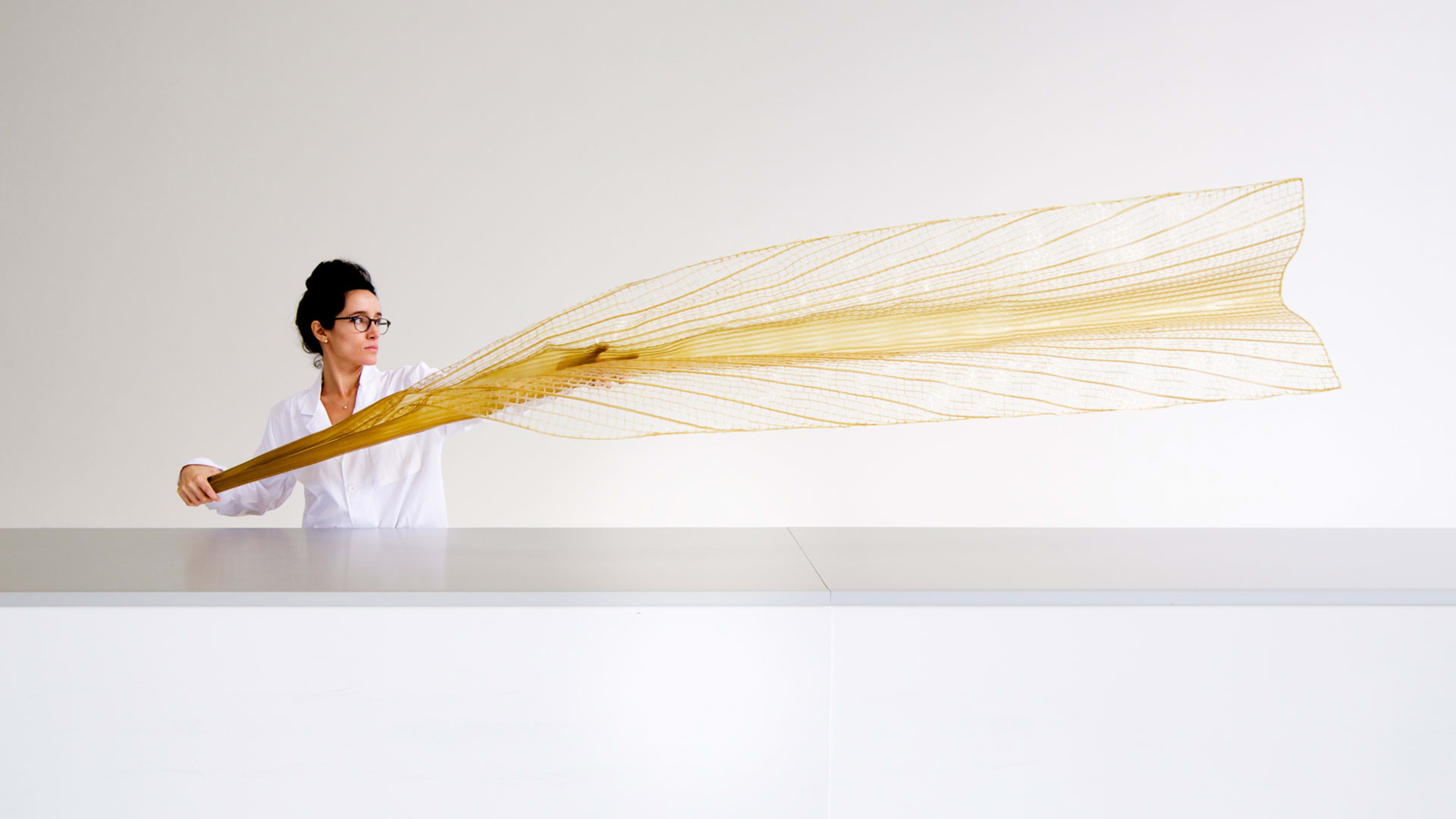Stepping into most any store and scanning the shelves of products, all packaged for consumption and destined for recycling or the dumps, makes you feel like a truly sustainable world is a daunting, if not impossible, prospect. But the Mediated Matter Group at the Massachusetts Institute of Technology, led by researcher and designer Neri Oxman, is hoping to get people to think differently about the objects and structures we make. With their latest research and art installation, Aquahoja I, the group created polymers derived from organic matter, 3D-printed by a robot, and shaped by water.
Mediated Matter calls this process “designing for decay.” Whereas most plastics, wood, glass, and metals are never recycled after they have outlived their function, the group’s biopolymers are designed to decompose upon reaching the end of its product life cycle, returning to the earth instead of being destined for a dump.
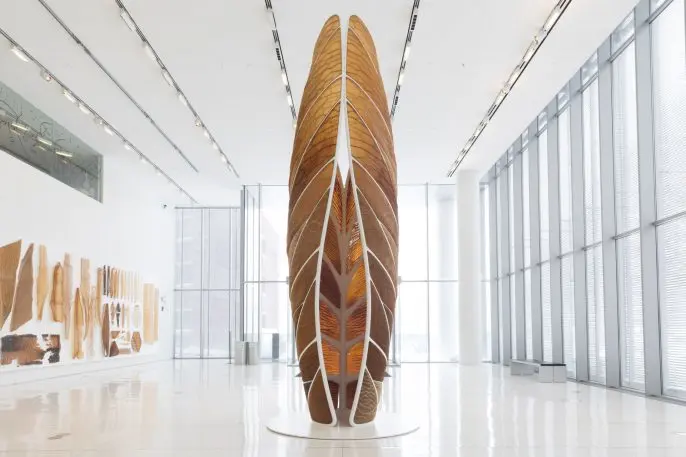
“Works included in this project are digitally designed and robotically manufactured out of the most abundant materials on our planet–the very materials found in trees, insect exoskeletons, apples, and bones,” the Mediated Matter group wrote in a statement. “Cellulose, chitosan, pectin, and calcium carbonate are combined and compounded with high spatial resolution over material tunability producing biodegradable composites with mechanical, chemical, and optical functional properties across length scales ranging from millimeters to meters.”
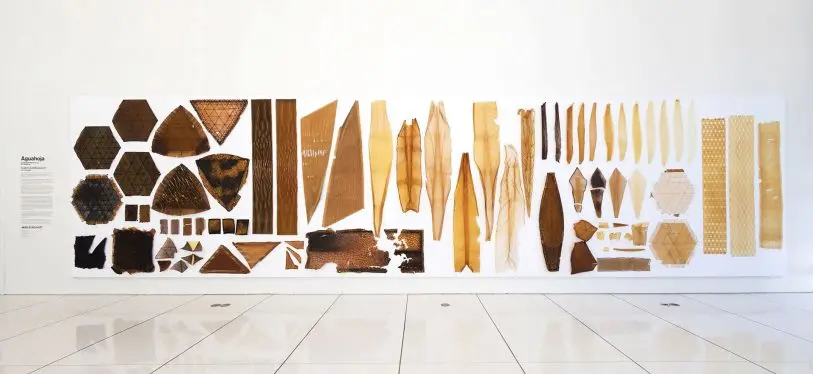
As Mediated Matter explained in a recent research paper, “Water-Based Robotic Fabrication,” chitosan, cellulose, and pectic can be stabilized and dissolved in water, as well as recycled within minutes. The group calls these water-shaped skin-like structures “hojas” (“leaf” or “sheet,” in English), which can be created at the architectural scale or as handheld products. The group also says they can be designed and fabricated as if they were grown and not manufactured. In fact, since the biopolymer is 3D-printed into the artifacts seen in the exhibition, no assembly is required.
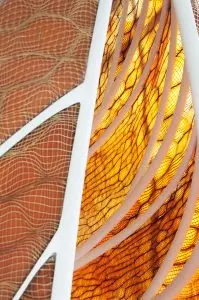
From afar, the pavilion resembles a fine art sculpture. Up close, however, the surface looks organic instead of synthetic.
As visually stunning as the pavilion is, the library of artifacts are equally intriguing, especially when considering the practical applications. Six years in the making, Mediated Matters calls these computationally grown artifacts “functional biopolymers.” In other words, they aren’t a design pipe dream, but full of product potential. The various objects’ iterations and designs suggest a near future with naturally decomposable packaging or even toys, which typically get thrown in a closet instead of being returned to the earth.
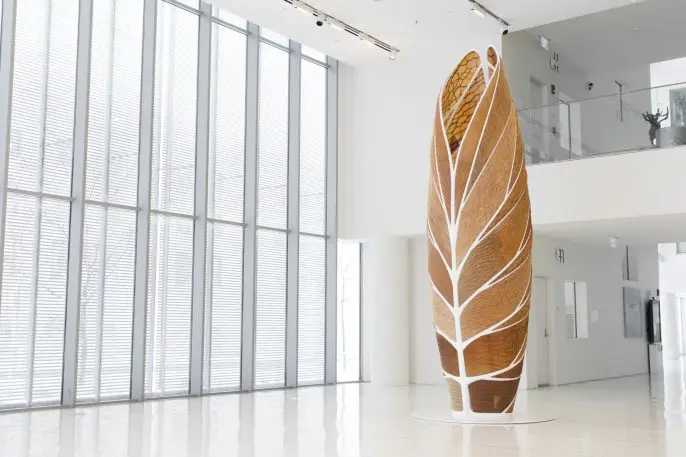
“The wide array of forms and behaviors embodied in both pavilion and artifacts reflects the manner in which they are expressed in nature, where a material such as chitin can compose both the exoskeletons of crustaceans and the cell walls of fungi,” says Mediated Matter. “In contrast to steel and concrete, the composites formed by these materials are in constant dialogue with their environment.”

“The surface area of [it] is limited only by the robotic gantry–a continuous construction modeled after human skin–with regions that serve as structure, window, and environmental filter,” the group explains. “At the end of its life cycle, when no longer useful, the structure can be programmed to degrade in water (e.g., the rain), thereby restoring its constituent building blocks to their natural ecosystem, augmenting the natural resource cycles that enabled its creation.”
Mediated Matter calls this process “environmental programming,” and the group foresees a future where the properties of built structures can be modified relative to seasons to encourage or inhibit decay. What is particularly interesting, but perhaps left understated by Mediated Matter, is that this system is scalable. In theory, an entrepreneur with software, a 3D printer, and the biological materials could create biodegradable products almost as easily as a corporation with mass production capabilities–financing and marketing considerations notwithstanding. And that wouldn’t just be great for the environment, but a win for independent businesses.
Mediated Matter is planning a second pavilion and library of associated artifacts called Aquahoja II, which will debut on May 20 as part of “Nature: Cooper Hewitt Design Triennial,” co-organized by the Cooper Hewitt, Smithsonian Design Museum, and Cube Design Museum in Kerkrade, Netherlands.
Recognize your brand’s excellence by applying to this year’s Brands That Matter Awards before the early-rate deadline, May 3.
